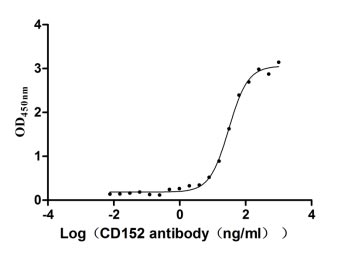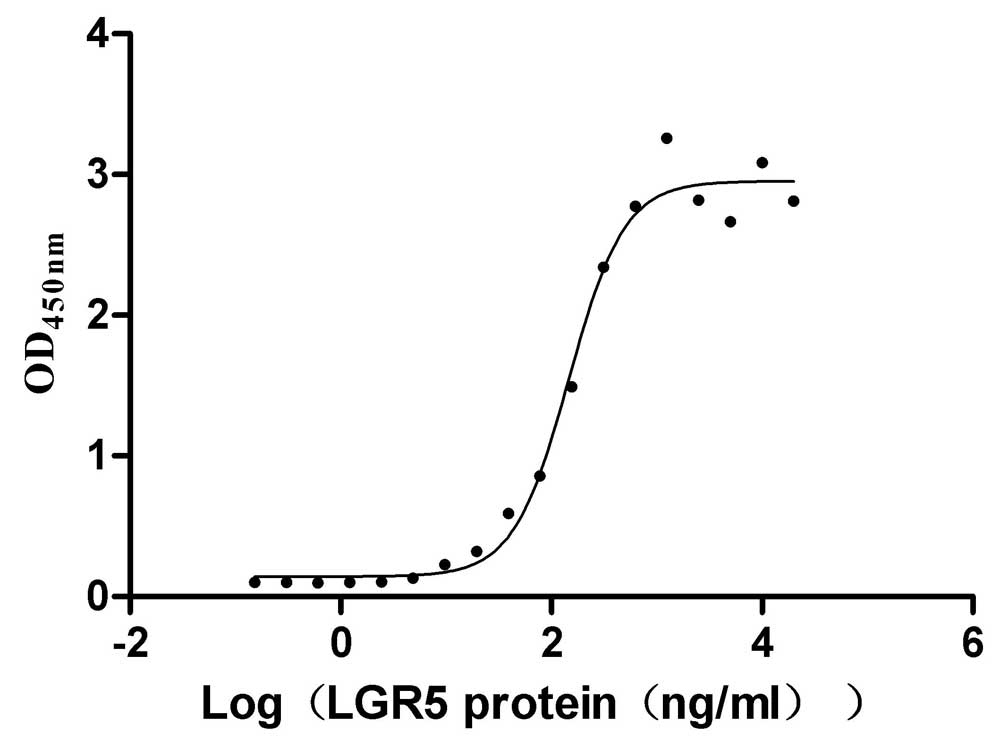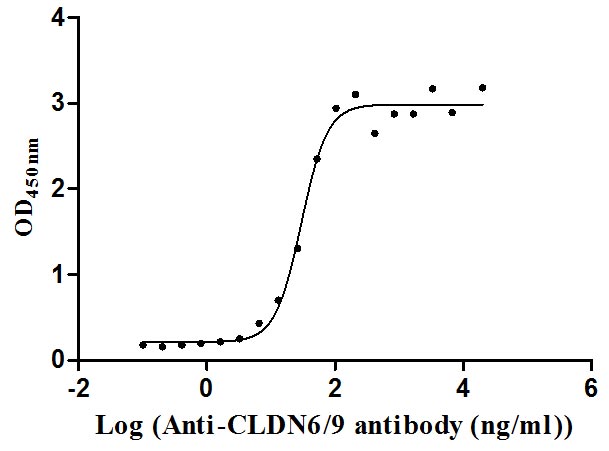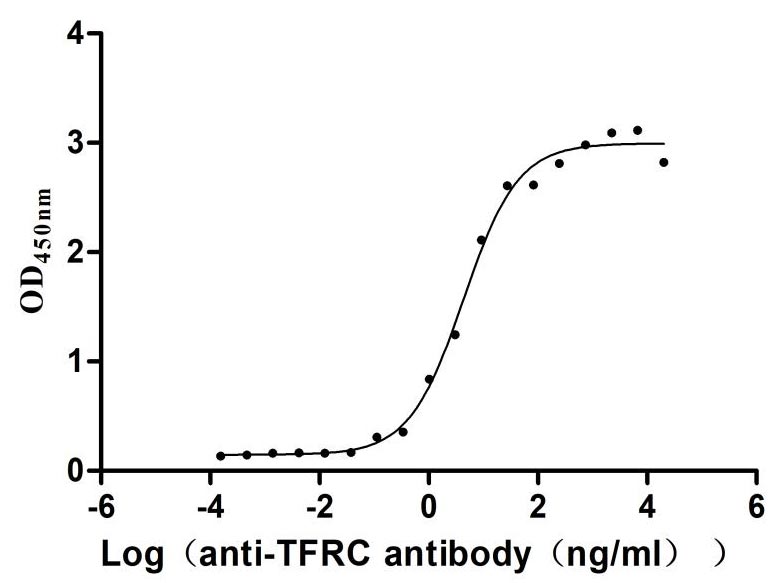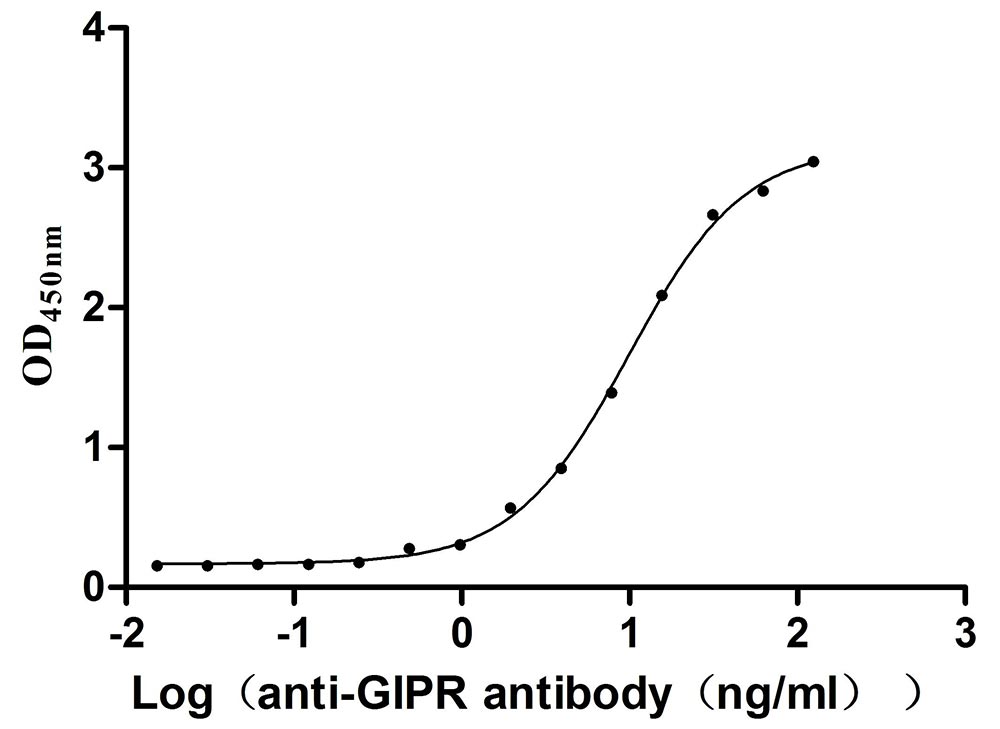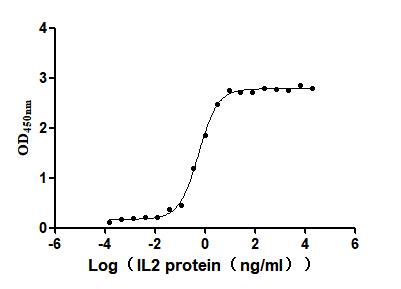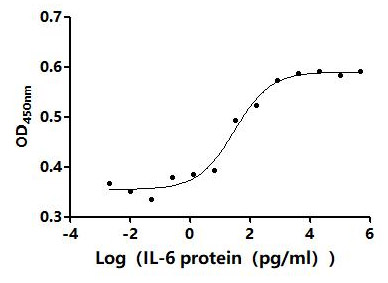Recombinant Human Heat shock factor protein 4 (HSF4)
-
中文名稱:人HSF4重組蛋白
-
貨號:CSB-EP890934HU-B
-
說明書:
-
規(guī)格:
-
來源:E.coli
-
共軛:Avi-tag Biotinylated
E. coli biotin ligase (BirA) is highly specific in covalently attaching biotin to the 15 amino acid AviTag peptide. This recombinant protein was biotinylated in vivo by AviTag-BirA technology, which method is BriA catalyzes amide linkage between the biotin and the specific lysine of the AviTag.
-
其他:
產(chǎn)品詳情
-
純度:>85% (SDS-PAGE)
-
基因名:HSF4
-
Uniprot No.:
-
別名:Cataract; Marner; CTM; Heat shock factor protein 4; Heat shock transcription factor 4; hHSF4; HSF 4; HSF4; HSF4_HUMAN; HSTF 4
-
種屬:Homo sapiens (Human)
-
蛋白長度:full length protein
-
表達區(qū)域:1-492
-
氨基酸序列MQEAPAALPT EPGPSPVPAF LGKLWALVGD PGTDHLIRWS PSGTSFLVSD QSRFAKEVLP QYFKHSNMAS FVRQLNMYGF RKVVSIEQGG LLRPERDHVE FQHPSFVRGR EQLLERVRRK VPALRGDDGR WRPEDLGRLL GEVQALRGVQ ESTEARLREL RQQNEILWRE VVTLRQSHGQ QHRVIGKLIQ CLFGPLQAGP SNAGGKRKLS LMLDEGSSCP TPAKFNTCPL PGALLQDPYF IQSPLPETNL GLSPHRARGP IISDIPEDSP SPEGTRLSPS SDGRREKGLA LLKEEPASPG GDGEAGLALA PNECDFCVTA PPPLPVAVVQ AILEGKGSFS PEGPRNAQQP EPGDPREIPD RGPLGLESGD RSPESLLPPM LLQPPQESVE PAGPLDVLGP SLQGREWTLM DLDMELSLMQ PLVPERGEPE LAVKGLNSPS PGKDPTLGAP LLLDVQAALG GPALGLPGAL TIYSTPESRT ASYLGPEASP SP
-
蛋白標簽:Tag?type?will?be?determined?during?the?manufacturing?process.
The tag type will be determined during production process. If you have specified tag type, please tell us and we will develop the specified tag preferentially. -
產(chǎn)品提供形式:Lyophilized powder Warning: in_array() expects parameter 2 to be array, null given in /www/web/cusabio_cn/public_html/caches/caches_template/default/content/show_product_protein.php on line 662
Note: We will preferentially ship the format that we have in stock, however, if you have any special requirement for the format, please remark your requirement when placing the order, we will prepare according to your demand. -
復溶:We recommend that this vial be briefly centrifuged prior to opening to bring the contents to the bottom. Please reconstitute protein in deionized sterile water to a concentration of 0.1-1.0 mg/mL.We recommend to add 5-50% of glycerol (final concentration) and aliquot for long-term storage at -20℃/-80℃. Our default final concentration of glycerol is 50%. Customers could use it as reference.
-
儲存條件:Store at -20°C/-80°C upon receipt, aliquoting is necessary for mutiple use. Avoid repeated freeze-thaw cycles.
-
保質(zhì)期:The shelf life is related to many factors, storage state, buffer ingredients, storage temperature and the stability of the protein itself.
Generally, the shelf life of liquid form is 6 months at -20°C/-80°C. The shelf life of lyophilized form is 12 months at -20°C/-80°C. -
貨期:Delivery time may differ from different purchasing way or location, please kindly consult your local distributors for specific delivery time.Note: All of our proteins are default shipped with normal blue ice packs, if you request to ship with dry ice, please communicate with us in advance and extra fees will be charged.
-
注意事項:Repeated freezing and thawing is not recommended. Store working aliquots at 4°C for up to one week.
-
Datasheet :Please contact us to get it.
相關產(chǎn)品
靶點詳情
-
功能:DNA-binding protein that specifically binds heat shock promoter elements (HSE).; Transcriptional repressor.; Transcriptional activator.
-
基因功能參考文獻:
- We have identified a novel mutation in HSF4 in a large British pedigree causing dominant congenital lamellar cataract PMID: 29243736
- High HSF4 expression is an independent indicator of poor overall survival and recurrence free survival in patients with primary colorectal cancer. PMID: 29131521
- In the cultured human lens epithelial cells, HSF4 could stabilize and retain p53 in the nucleus to activate its target genes such as fas cell surface death receptor (Fas) and Bcl-2-associated X apoptosis regulator (Bax). PMID: 28981088
- report on a novel homozygous HSF4 mutation (c.521T>C, p.Leu174Pro) in two sibs with congenital cataracts PMID: 26490182
- BCAS2 interacts with HSF4 and negatively regulates its protein stability via ubiquitination. PMID: 26319152
- HSF4 may work as a switch between lens epithelial cell proliferation and secondary fiber cell differentiation, a process which mainly depends on p53. PMID: 25940838
- concluded that the new mutation of c.331C>T in HSF4 DNA may be responsible for the autosomal dominant congenital cataract in this family PMID: 25877371
- HSF4 p.Arg116His recreates the childhood lamellar cataract in mice suggesting that incomplete penetrance associated with early cataracts may not be an absence but a limitation of the detection of the phenotype PMID: 24975927
- This is the first report of the novel missense mutation, c.69 G-->T (p. K23N), in exon 3 of the HSF4 locus on 16q21-q22 associated with bilateral congenital cataracts in a Chinese family. PMID: 24637349
- the transcriptional activation of HSF4 is mediated by interactions between activator and repressor domains within the C-terminal end. PMID: 24045990
- HSF4 exerts its function on lens differentiation via positive regulation of DLAD expression. PMID: 23507146
- HSF4 and WRN CNVs might be involved in ARC pathogenesis in the Han Chinese. PMID: 23329665
- Presents the first evidence demonstrating that HSF4 plays a role in DNA damage repair and may contribute a better understanding of congenital cataract formation. PMID: 22587838
- we report the absence of mutations in all studied genes in four families with phenotypes associating cataract, mental retardation and microcephaly. PMID: 22103961
- HSF2 and HSF4 regulate transcription of HIF-1a and that a critical balance between these HSF is required to maintain HIF-a expression in a repressed state. PMID: 21258402
- two missense mutations that have been associated with age-related cataract did not or only slightly alter HSF4 activity, implying that other genetic and environmental factors affect the functions of these mutant proteins. PMID: 20670914
- Hsf4b could interact with and phosphorylated by MAP kinase P38. PMID: 20564821
- Mutant DNA-binding domain of HSF4 is associated with autosomal dominant lamellar and Marner cataract. . We suggest that HSF4 is critical to lens development. PMID: 12089525
- This is the first report describing association of an autosomal recessive cataract with the HSF4 locus on 16q21-q22.1 and the first description of HSF4 splice variants PMID: 15277496
- HSF4 binds to alphaB-crystallin, Hsp70, and Hsp82 promoters and has a role in interacting with the canonical heat shock element of the alphaB-crystallin gene PMID: 15308659
- Findings confirm that mutations in HSF4 may result in both autosomal dominant and autosomal recessive congenital cataract, and highlight the locus heterogeneity in autosomal recessive congenital cataract. PMID: 15959809
- The results indicate that in the absence of Hsf1 and Hsf2, Hsf4b expression in cells leads to increased ability of Hsf4b to bind HSE during G1, leading to enhanced synthesis of inducible Hsp70. PMID: 16552721
- These results identified a novel missense mutation R74H in the transcription factor gene HSF4 in a Chinese cataract family and expand the spectrum of HSF4 mutations causing cataract. PMID: 16876512
- This result indicates that HSF4 mutations account for only a small fraction of age-related cataracts. PMID: 18941546
- we have shown the first nonsense mutation in HSF4 causing autosomal recessive cataracts in a large consanguineous family from Pakistan PMID: 19014451
顯示更多
收起更多
-
相關疾病:Cataract 5, multiple types (CTRCT5)
-
亞細胞定位:Nucleus.
-
蛋白家族:HSF family
-
組織特異性:Expressed in heart, skeletal muscle, eye and brain, and at much lower levels in some other tissues.
-
數(shù)據(jù)庫鏈接:
Most popular with customers
-
Recombinant Human Cytotoxic T-lymphocyte protein 4 (CTLA4), partial (Active)
Express system: Mammalian cell
Species: Homo sapiens (Human)
-
Recombinant Human R-spondin-1 (RSPO1), partial (Active)
Express system: Mammalian cell
Species: Homo sapiens (Human)
-
Recombinant Human Claudin-9 (CLDN9)-VLPs (Active)
Express system: Mammalian cell
Species: Homo sapiens (Human)
-
Recombinant Human Transferrin receptor protein 1 (TFRC), partial (Active)
Express system: Mammalian cell
Species: Homo sapiens (Human)
-
Recombinant Mouse Gastric inhibitory polypeptide receptor (Gipr), partial (Active)
Express system: Mammalian cell
Species: Mus musculus (Mouse)
-
Recombinant Human Interleukin-2 (IL2) (Active)
Express system: Mammalian cell
Species: Homo sapiens (Human)
-
Recombinant Human CD70 antigen (CD70), partial (Active)
Express system: Mammalian cell
Species: Homo sapiens (Human)
-


